More than a quarter of Aussie millennials are currently living at home with their parents as housing affordability drifts further and further from reality for many.
New data from Finder has revealed that 28% of millennials and 25% of Gen X still lived with family by the age of 30, compared to just 8% of Baby Boomers.
In addition, 62% of Baby Boomers had bought their first home by the age of 30, whereas just 34% of millennials had done the same.
The housing crisis, which has been exacerbated dramatically during the COVID pandemic, is stopping the vast majority of the younger generation from achieving the same major life milestones as the generations above them.
At the same time, rental prices are also soaring, further squeezing the younger generations who make up the majority of the rental market.
A new report from the ACOSS/UNSW Sydney Poverty and Inequality Partnership has shown that every Australian capital city and regional area has seen rent rises during this crisis period “far in excess of wage increases or CPI-linked payment adjustment”, with the exception of Sydney and Melbourne.
The Finder data however refutes this, stating that the price of the average Sydney home went up 25%, while wages increased by just 2.2%.
Regional rents are now 18% higher than they were two years ago, according to ACOSS, more than tripling the average rise in wage growth over the same period.
State-level figures show that the situation for regional renters in Tasmania and Western Australia is particularly difficult because of even larger housing cost increases.
The comparative global survey found that this trend fits with the international picture. Rents are at historically high rates in Australia, the UK, Canada, Ireland, New Zealand and the US, with Australia topping the charts for house price inflation at 22%.
Unlike the global financial crisis of 2008, which saw major drop offs in house prices, there has been no price decline following the current global catastrophe.
The report states that all eight countries surveyed took extensive financial measures to safeguard housing and prevent homelessness, including rental freezes and financial payments.
However, it notes that Australia’s policy of stimulating the housing market through homebuilder grants exacerbated the problem as this, combined with record low interest rates, drove demand up and therefore house prices too.
Sarah Megginson, senior editor of money at Finder, said housing affordability had reached fever pitch.
“Many young people are concerned that unanticipated price growth over the last couple of years has ruined their chances of buying a home.
“The pandemic had a disproportionate impact on young Aussies, who were more likely to lose work or have their studies disrupted.
“They’re also the least likely to have benefitted from rising house prices – resulting in a double whammy blow to their finances.”
Despite low interest rates reducing borrowing costs for homebuyers, Finder analysis found Millennials are paying 4.9 times more for a home than Baby Boomers did.
Megginson however said that the future is not as dire as some might think.
“Aussies aren’t just putting off homeownership because they can’t afford it – many young people are choosing to take time to travel or invest in their studies,” she said.
“Now that some of the heat has come out of the property market, and with prices expected to fall slightly in the year ahead, you might actually be in a better position to buy in the near future.
“If you want to buy sooner than later, there are low-deposit home loans that help you purchase a home with as little as 5% deposit.
“Just make sure you crunch the numbers so you know you can afford your mortgage repayments.”
Read more stories from The Latch and subscribe to our email newsletter.

